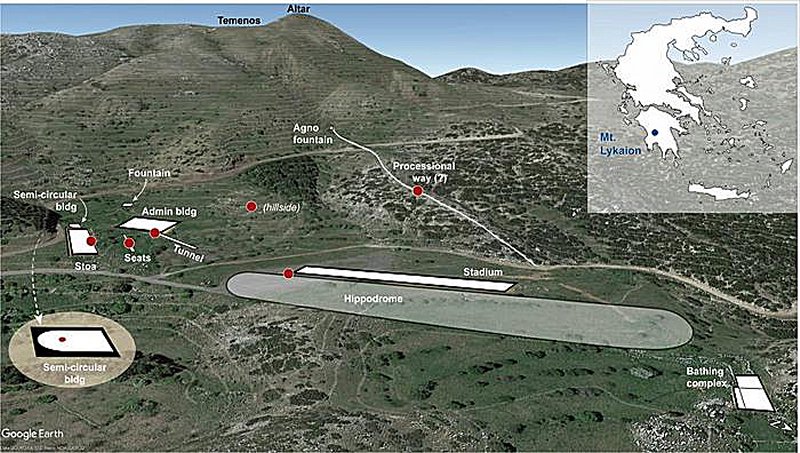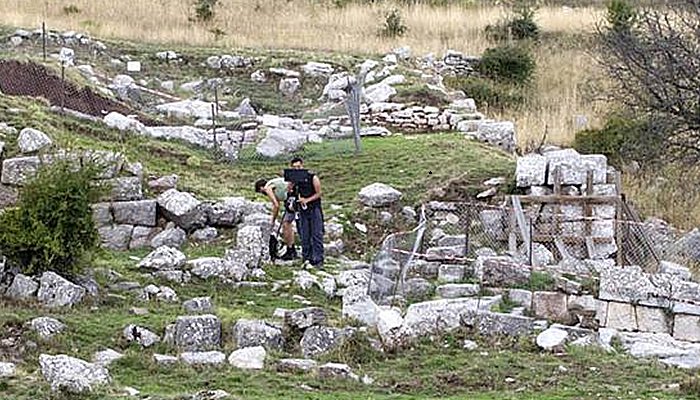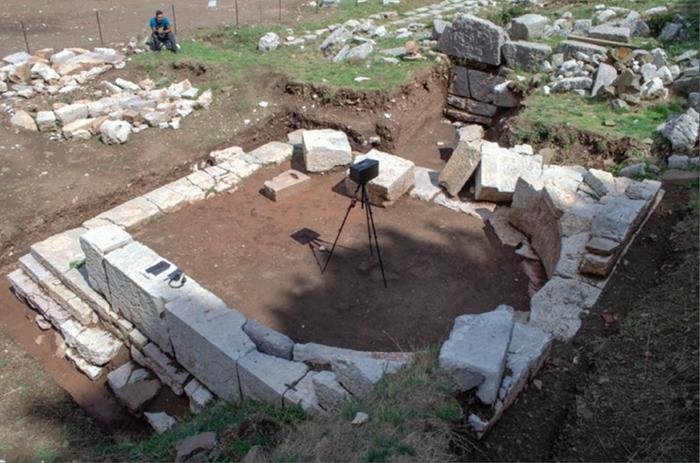Conny Waters – AncientPages.com – Understanding the way in which sounds move through archaeological sites could offer insights into how ancient societies may have organized themselves.
Excavated building with semi-circular interior stone wall, speaker placed at focal point of curve. Image credit: Pamela Jordan
Until recently, archaeologists have mostly relied on what they can see at the sites of ancient ruins to unlock the secrets of the past. But lately, new methods have started to allow researchers to use other senses to explore these sites in different ways.
One such method is ‘psychoacoustics’, which studies how sounds are perceived by humans. In a recent study published in the journal Open Archaeology, Pamela Jordan from the University of Amsterdam used this technique to gain greater insight into how an ancient Greek sanctuary may have been used by ancient visitors.
Recording how sounds interact among different structures can provide an idea of what they were designed for, and what activities could have taken place in the terrain surrounding them. “If you use sound as the basic frame […] you inherently start from a place of connection and a place of interrelation between portions of the site,” said Jordan.

Bird’s eye view of the Sanctuary for Zeus with built remains outlined (white text denotes lower sanctuary components). Recording points are shown in red. Image credit: Pamela Jordan
In the study, Jordan and her team used psychoacoustics at the ancient sanctuary of Zeus on Mount Lykaion in Greece, roughly 160 kilometers from Athens. Over four recording sessions between 2015 and 2022, they played pre-recorded sounds, ranging from white noise to speeches, at different points at the site. These sounds were recorded at another location at the site using two microphones positioned close together, to mimic human ears (known as binaural recording). Digital tools then helped evaluate the sound frequency and clarity ‘heard’ at different points.
In total, over 1600 recordings were made in 2022 alone, allowing the research team to analyze dozens of sound relationships at different points of the sanctuary.
For example, Jordan noted that other archaeologists suggested that sounds from the site’s hippodrome could easily be heard from a hillside to the west. Acting on this recommendation, their recordings showed that the hippodrome’s surface indeed reflected sound to both the audience at the hippodrome and to those who might have gathered at the hillside.

Field ᴀssistants setting up a speaker and meteorological testing devices at the southern entrance of a tunnel leading to the hippodrome. Image credit: Pamela Jordan
This means the hillside might have acted as an important spectating site. Interestingly, switching the speakers and microphone positions showed that sound from the hillside could also be clearly heard in the hippodrome. This would have been important if the site was indeed used by spectators, explained Jordan.
“Spectating at that time in a ritual context was very active; it was an exchange with the athletes and the people who were actually conducting the ritual,” she said. “So they needed the crowd input as part of this reciprocal relationship.”
They also measured sound at smaller scales. One ruin of a semi-circular building showed that it likely reinforced an individual’s movements in the area, creating a unique ‘heightened sonic environment’ in the sanctuary.
“Semicircular shapes in Hellenistic architecture are rare, but they do occur,” said Jordan. “They are often found in a sanctuary as a place for votive offerings, so it could have been dedicated to a specific donor or a specific deity — that’s a possibility.”
However, Jordan advised against drawing too many conclusions from such early results. There is still not enough evidence that the sonic effects they found were intentional. Even if they were, our modern interpretation of those sounds may be different to those of the ancient Greeks living there.
“When you have a tool and a set of data to back up an experience of yours as objective, it’s very easy to think that was the experience that an ancient group of people also had,” said Jordan. “It doesn’t take into account so many other factors that we have only barely scratched the surface of in terms of cultural ᴀssociation.” For example, she noted, we do not know if those hearing thunder at the sanctuary may have experienced either awe or fear.
Jordan is hopeful the method will become more popular in the years to come, and would like to expand her psychoacoustic studies to other sites in the future. She is optimistic that the method has potential to expand how archaeologists interpret ancient sites.
“It opens up accessibility to these spaces for people who don’t necessarily depend on sight,” she said. “As a result, it opens all of us up to the possibility of not depending on sight to interpret historic value.”
Paper: Pamela Jordan, Employing Psychoacoustics in Sensory Archaeology: Developments at the Ancient Sanctuary of Zeus on Mount Lykaion, Open Archaeology (2023). DOI: 10.1515/opar-2022-0329
Original story – De Gruyter via Eurekalert
Written by Conny Waters – AncientPages.com Staff Writer






